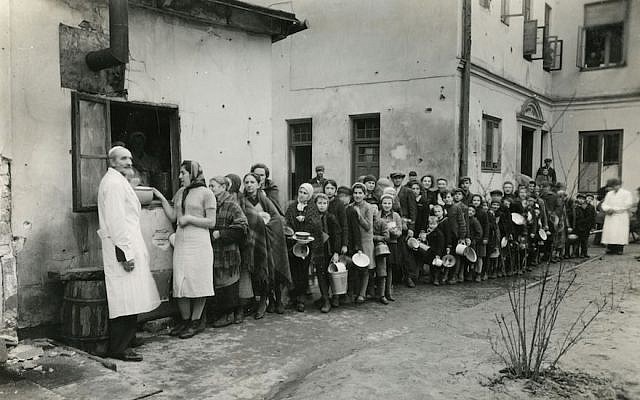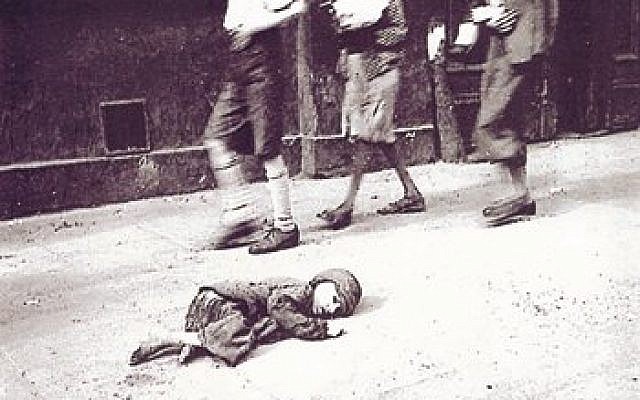Research led by Tel Aviv University bio-mathematician discovers astonishingly simple means used by starved, persecuted Jews to stop typhus in its tracks
By TOI STAFF

Illustrative: Jews are seen lining up in the Warsaw Ghetto during World War II. (Courtesy of American Jewish Joint Distribution Committee Archives via JTA)<
The Warsaw Ghetto, November 1941. Some 450,000 people, most of them Jews, were packed into an area of some 1.3 square miles, ten times the density of modern-day high-rise cities.
Typhus was spreading like wildfire through the dirty, crowded streets of the ghetto. Typhus, the Nazis said, was why a ghetto was necessary in the first place; Jews spread disease.
Ten of thousands lay ill and dying, and a harsh winter — when the sickness caused by the typhus bacterium is especially virulent — was still ahead.
The Nazis blocked food and supplies from getting in. Thousands were dying from famine, and those who lived were more susceptible to infection and death.
Then, inexplicably, miraculously, despite the ideal conditions for typhus’s spread, the disease ebbed away. Historians couldn’t explain it, and witnesses at the time called it miraculous.

A German soldier barks out orders to Jewish men in the Warsaw Ghetto in 1941. (Galerie Bilderwelt/Getty Images/ via JTA)
Now, a team led by Tel Aviv University bio-mathematician Lewi Stone thinks it has an answer to the mystery.
It is, simply and incredibly, social distancing.
When the Nazis herded hundreds of thousands of Jews, Roma and others into the ghetto, some 800 doctors and thousands of nurses and other medical professionals went with them.
Typhus is spread by lice, and can be stopped in its tracks by good hygiene and social distancing.
The doctors interned in the ghetto knew that, and embarked on a far-reaching program that included lectures, the opening of a secret underground medical school and calls to socially distance.

Nazi liquidation of the Warsaw Ghetto. (Courtesy of USHMM)
“Residents were terrified of accidental contact and practiced social distancing,” the researchers wrote.
They added: “There were hundreds of public lectures on the fight against typhus and epidemics. An underground university was set up to train young medical students, and scientific studies on the phenomenon of starvation and of epidemics were undertaken. Building and apartment cleanliness was encouraged and often enforced. Social distancing was considered basic common sense by all, although not enforced. Home self-isolation was put in practice, although not comprehensively.
“Last, complex and highly elaborate sanitation programs and measures were developed by the Health Department and [Jewish] Council with the goal of eradicating typhus. These efforts under the given conditions were what Adina Blady-Szawjger, a surviving doctor of the Warsaw Ghetto, called ‘superhuman medicine’ after the war. It is proof of the successful politics of the Jewish Council, which often was blamed as being corrupt and incompetent,” the researchers said.
The results were astounding.
As the historian Emanuel Ringelblum, who chronicled ghetto life, wrote in November 1941, “The typhus epidemic has diminished somewhat — just in the winter, when it generally gets worse. The epidemic rate has fallen some 40 percent. I heard this from the apothecaries, and the same thing from doctors and the hospital.”
It can seem well-nigh impossible for hygiene and social-distancing campaigns to work under the cramped, starved conditions of the ghetto, but it did.

A child dying in the streets of the Warsaw Ghetto (photo by Heinz Joest, a Wehrmacht sergeant, Wikimedia Commons)
“There are no other reasonable alternative hypotheses to explain the early demise of the epidemic at the onset of winter,” said the researchers, after modeling multiple scenarios in the search for what happened.
Mathematical models based on case reports in the lead-up to November 1941 suggest over 300,000 should have contracted the disease, three times the numbers that actually did.
“It’s one of the great medical stories of all time,” physician and historian Howard Markel, who coined the term “flatten the curve,” told The Christian Science Monitor.
“We should take heart and inspiration from the courage, bravery, and unity of doctors, nurses, and patients alike to combat an infectious foe. We need to do that today, and they did it under much more dire circumstances,” he said.
In the end, some 30,000 ghetto residents died from typhus by the time the ghetto was liquidated and its residents sent to die in Treblinka’s gas chambers.



You cannot make this up.
Oops, apparently you can.
A Friend placed the following comment under the article at ‘Times-Of-Israel’
The comment was taken down by them, shortly after coming online:
Perverse revisionism of history conjured up here. I just got off the phone with my mother who lived through Ghetto Warsaw almost to its end. She reconfirmed what is common knowledge. Streets were so overcrowded you cannot imagine. Apartments packed whole families into each room, hallway, nook or cranny. Social distancing under the Nazi’s? Are you out of your minds? For your info, I know what I am talking about. My grandmother worked for the medical board in the Warsaw Ghetto.
Evidently, you hope to find fault with the government not doing enough to combat the Corona pandemic today, falling short in applying social distancing.
They are doing fine as is.
Case fatality Italy/UK/France 14%, US 3.5%, Israel 0.76%.
Obviously, you want to force additional lockdowns, closing of businesses, in the hope the failing economy will topple Bibi and or Trump.
Rewriting the Shoah for propaganda motives is feckless, evil, and depraved.
@ Adam Dalgliesh:
The overall number stayed the same during the first year and a half because the people from the outside were still brought in to replace those already dead.
You can’t have social distancing at almost 10 people per room. There were several hundred thousand people in less than 1.5 sq. miles.
Anyway, typhus is not spread from person to person, it is spread by infected lice.
In the ghetto, they might have managed to exterminate the lice and stop or slow down the epidemic this way but it has nothing to do with social distancing.
“During the first year and a half, thousands of Polish Jews as well as some Romani people from smaller towns and the countryside were brought into the Ghetto, but as many died from typhus and starvation the overall number of inhabitants stayed about the same.” This is from the Wikipedia’s article about the Warsaw ghetto. If it is accurate, then the Israeli professor about the ghetto doctors bringing the typhus epidemic under control.
Apparently, the Nazis did not cut off water and sewer service to the ghetto, although had they done so, they would have been saved from the trouble and expense of sending large numbers of temporary survivors to the death camps.
This guy is a real weirdo. There was no way to observe social distancing when Jews were packed together like sardines in the ghetto. Did the Nazis cut off water and sewer service to the ghetto? If they did, good hygience would have been impossible. In any case, very few Jews survived the ghetto. I have read that the death rate from typhus and other infectious diseases was very high in the ghetto. A large part of the population had died even before the deportations to the death camps began.